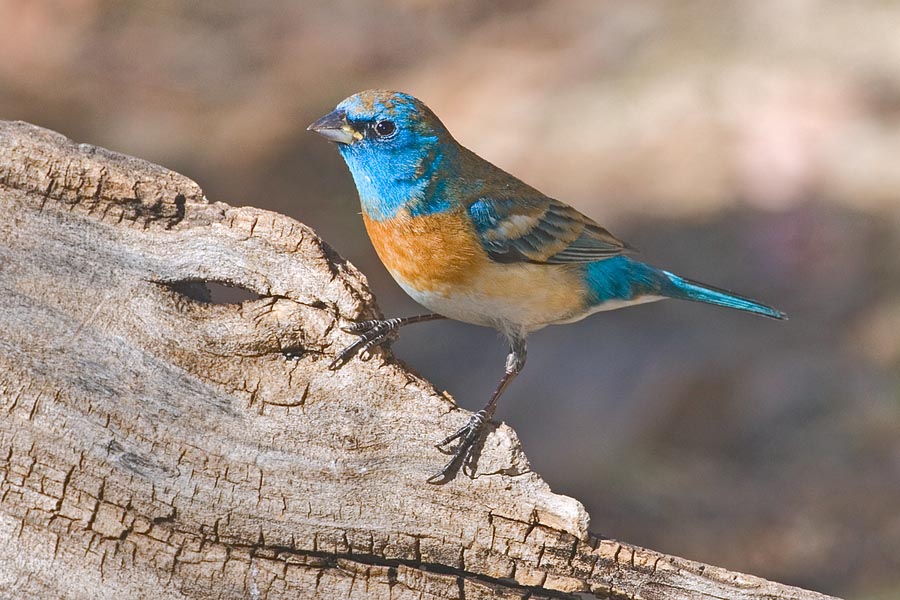The Lazuli Bunting (Passerina amoena) is a small, finchlike songbird. They’re heavyset, have gently sloping foreheads, and cone-shaped bills. Their tails are slightly notched as well. This bird is named after lapis lazuli because of the male birds rich color on their backs.
They stand out against their habitats of thickets, gardens, and dry brushy hillsides of the West. They have a beautiful mix of blue and orange.
These birds belt out jumbled, squeaky songs from the tops of shrubs to defend their territory. These finchlike songbirds are related to grosbeaks and cardinals. They’re often seen visiting bird feeders, especially those filled with white millet.
Identification
Male Lazuli Buntings have pumpkin-colored breasts, white bellies, and brilliant blue upper parts. Males also have a white shoulder patch that stands out when the birds are flying or perched.
These birds are commonly mistaken for Indigo Buntings, which is understandable. Both birds have a striking blue color and are absolutely beautiful. However, there’s an important distinction between the two. Male Indigo Buntings are completely blue. If you see a bird with some blue, it’s most likely a Lazuli Bunting.
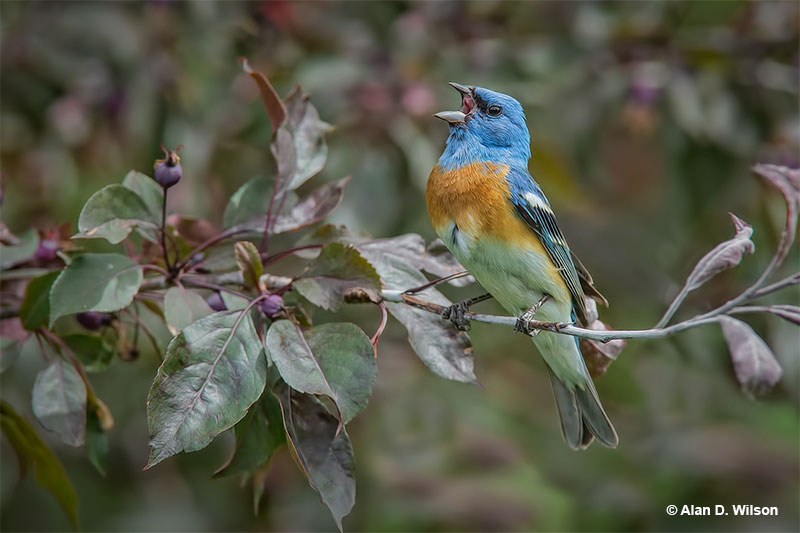
© Alan D. Wilson
Female Lazuli Buntings have two buffy wing bars, are warm grayish-brown above, have an unstreaked pale tan or cinnamon breast, and have a tinge of blue on the wings and tail.
Nonbreeding males and Juvenile Lazuli Buntings have the pumpkin color on their breasts but have tan and mottled blue on their heads and backs. Males are eye-catching in summer. They perch and sing in the open, while the duller females stay hidden and tend to their nests.
Food
Lazuli Buntings primarily eat insects. However, they often consume fruit and stop at bird feeders to eat millet too. Some of the insects Lazuli Butnings consume are caterpillars, grasshoppers, spiders, ants, butterflies, beetles, and other insects they can find in the understory of grasses and leaves.
Some fruit they’ve been known to eat are serviceberry, wild oats, chickweed, chokecherry, and other grasses.
If you would like to attract these birds to your backyard feeder, we recommend filling one feeder with white proso millet.
Nesting and Eggs
Female Lazuli Bunting chooses the nest’s location. The nests are usually in a type of shrub such as wild rose, willow, ninebark, snowberry, Oregon grape, or blackberry. The nest is usually near the edge of the shrub and at most 3 feet off the ground.
The female Lazuli Bunting will collect strips of bark, leaves, and grasses that she’ll weave with silk from tent caterpillars or spiderwebs to form a cup-shaped nest.
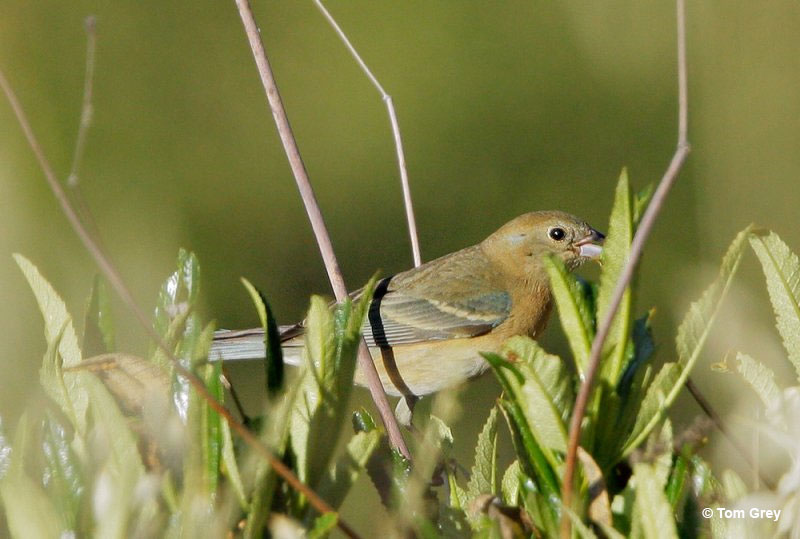
© Tom Grey
It takes 5 to 7 days to complete, and the finished product will be 3.5 inches wide with an inner cup around 2 inches wide.
- Clutch size can range from 3 to 4 eggs.
- Lazuli Buntings can have 1 to 2 broods.
- Egg length ranges from 0.7 to 0.8 inches (1.7 to 2.1 centimeters).
- Egg width ranges from 0.5 to 0.6 inches (1.3 to 1.5 centimeters).
- Incubation periods can range from 1 to 14 days.
- The nestling period can be anywhere from 9 to 11 days.
- Eggs can range in color from pale blue to faint greenish-blue or white.
Current Situation
Lazuli Buntings live near streams, brushy hillsides, wooded valleys, residential gardens, thickets, and hedges along agricultural fields from sea level to more than 9,500 feet in elevation.
They also take advantage of areas that have been recently burned. In western Mexico, on their wintering grounds, they’ll use thorn forests, overgrown fields, second-growth pine-oak forests, hedgerows, and agricultural areas. They love to fly-catch, which means they love to catch their food while in flight.
Male Lazuli Buntings tend to do this from exposed, taller perches while female Lazuli Buntings prefer to fly-catch from sheltered, lower perches.
The Lazuli Bunting is a commonly seen bird throughout the West. Their numbers have remained stable since the late 1960s. Their estimated breeding population is 5.6 million.
They’re marked as a species of low concern on the ICUN Red List. However, that doesn’t mean these birds aren’t at risk of population decline.
Lazuli Buntings are a species of bird that uses cup-nesting. This makes them vulnerable to Brown-headed Cowbirds. Brow-headed Cowbirds lay their eggs in the nests of other bird species and rely on the different species’ parents to raise the young at their own expense.
Facts
- Most bird species will shed their feathers while on their wintering or breeding grounds. However, the Lazuli Bunting does not. After breeding, Lazuli Buntings will start shedding some of their feathers but will then begin migrating to northwestern Mexico and the southwestern U.S. In these locations; insects are plentiful due to the monsoon rains. They’ll finish restoring their feathers in these locations before they continue to head even farther south for the winter.
- Every human has their own voice; male Lazuli Buntings are the same way! Each individual has a special sequence of notes. Juvenile males usually arrive at their breeding grounds and don’t have a song of their own. Not long after arriving at the breeding grounds, the juveniles will create their own song by combining song fragments from other males and rearranging syllables. The song they create is one that they keep for life.
- The oldest Lazuli Bunting on record was a male. He lived to be no less than 9 years and 1 month old. He was initially captured, banded, and released in 1981 in the state of Idaho. He was then recaptured and rereleased in the same state in 1990.
Similar Species
The Lazuli Bunting has features that are similar to other bird species. Here are some similar species:
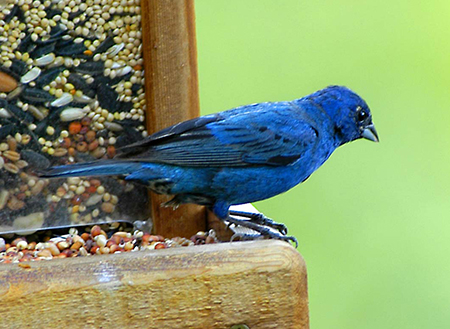
Indigo Bunting
Male Lazuli Buntings have blue upper parts, while Male Indigo Buntings are completely blue.
In addition, female Lazuli Buntings have gray throats and unstreaked breasts.
Meanwhile, female Indigo Buntings have whitish throats and streaks on the sides of their breasts.
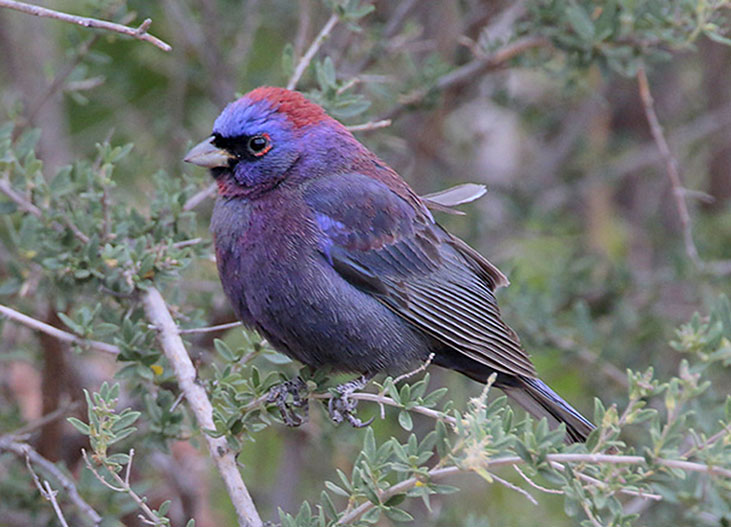
Varied Bunting
Female Lazuli Buntings don’t have two buffy wing bars, while Varied Buntings do.
Varied Buntings have more purplish tones in their plumage too, with some red in there too.
Plus, they are easy to spot by their puffed breast.
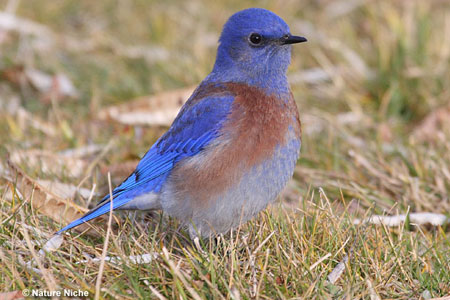
western bluebird
Lazuli Buntings are smaller, have thicker bills, and no wing bars, unlike the Western Bluebird.
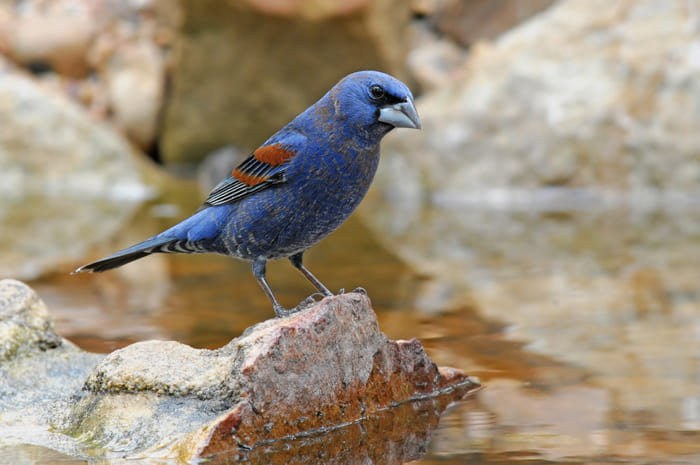
Blue Grosbeak
Lazuli Buntings are smaller than Blue Grosbeaks and have lighter bills.
Additionally, male Lazuli Buntings don’t have the rufous wing bars and blue bellies that Blue Grosbeaks have.
Female Lazuli Buntings have buffy wing bars, while Female Blue Grosbeaks have browner wing bars.
FAQ
Are Lazuli Buntings rare?
No, Lazuli Buntings are not rare. They’re a Widespread bird with stable numbers.
Where are Lazuli Buntings found?
Lazuli Buntings are found in areas near streams, brushy hillsides, wooded valleys, residential gardens, thickets, and hedges along agricultural fields from sea level to more than 9,500 feet in elevation. In western Mexico, on their wintering grounds, they’ll use thorn forests, overgrown fields, second-growth pine-oak forests, hedgerows, and agricultural areas.
What color is a Lazuli Bunting?
Lazuli Buntings are pumpkin-colored, white, and brilliant blue.
What attracts Lazuli Buntings to your yard?
You can attract Lazuli Buntings to your yard with white proso millet and a bird bath.

